Requiem for a Traffic Island
No. 143
In the fall the pecan foragers come out when the fruit starts to drop from the trees around East Austin. You might see them as you are driving to work or waiting for the bus, working their way through the grass of some empty lot, picking the nuts from the ground left by big old trees and putting them into brown plastic bags from the store, the kinds of bags that were briefly illegal here until the state legislature ruled that to ban such things is an inappropriate infringement on liberty. Over the years, I came to appreciate some of the choice spots around here, when I saw people come back to them often. In time, I began to appreciate how long human beings have enjoyed the fruit of Carya illinoinensis, and the window the foragers gave into deep time. Especially when you learn that some of the trees in our urban landscape may be older than the city.
One of the biggest I have ever seen is the one that looms over the courtyard of the house my wife designed for her parents in East Austin. The trunk is just across their property line, but the rootbed and canopy envelop that whole corner of the block, and the house is designed around it, in compliance with the development code requirements designed to afford urban trees a measure of protection other urban flora and fauna do not get. When you stand there in the courtyard, it looms so tall that it’s hard to really take in, rising well over a hundred feet. You know it was there long before the power plant was built a block away, and before the families moved into the double-wides that sandwiched it for decades until the plant was decommissioned, and gentrification overtook the neighborhood as soon as the noise and pollution were gone. When they finally moved in, I remember how my father-in-law would occasionally gripe about the tree and the mess it made, before Parkinson’s disease locked him in the house and it became hard to get from room to room, let alone look up to the sky.
Saturday afternoon, after he died in the morning, at the end of a long week at the hospital, the sun came out and I took our dog for a walk while Agustina and our daughter helped out at grandma’s house. Lupe’s old bones and gray whiskers are a pretty good measure of the years we have spent here, since that first summer when our neighbor Gina rescued her and her sister from the couch they were sleeping on as puppies behind the diner, and we adopted her while some other neighbors adopted Lucy. They are blackmouth curs, an unaccredited breed of Southern retrievers, not as native to this place as the ancient trees that grow in the floodplain or the black vultures that hang out patiently waiting for fresh roadkill here where the cars and trucks come roaring off the tollway, but just as fully adapted to it. And Lupe is always ready for a walk, even when we have missed a day, or her hips slow her as she climbs up the stairs of our weird little subterranean house.
One of our favorite spots for short rambles in recent years has been the empty lot between the onramp and offramp, a pocket of urban negative space created by the convergence of roads leading from north and west to the bridge across the river and the highway to Houston. I’ve written about that spot a lot in this newsletter. The idea of the deserted traffic island encodes an easy Ballardian riff, one that works well in part because it is true. There’s a passage about it in the book I turned in the last editorial revisions to on Tuesday, recalling the nested pair of red-shouldered hawks I saw mating there early in the pandemic, on the low branch of a tall pecan at the edge of the woods. The lot is tiny at the tip, but was always packed with life, and sometimes shared by a latter-day Crusoe. The old basketball hoop that rose up from the tall grass at the pocket forest’s edge let you know it was no remnant, but a recent rewilding. The sign that went up advertising the office space to come let you know how endangered it was, but as its computer-rendered vision faded from long seasons of sun and the interest rates kept climbing, I wondered if it would ever come.
Over the summer, orange fences went up around the big old trees. To protect them from the construction that would surround them, I assumed. Until this week, when I found them excavated around the root beds and wrapped in cloth and plastic mesh, apparently in preparation for relocation to some new home. Despite years of walking that lot, only when I saw them packaged up that way, as a group, did I realize what a perfect grove they made. Maybe not a sacred grove, but definitely a place where a little bit of the magic of the wild was allowed to persist inside the machine of the city.
The denser woods that filled in the tip of the triangle had been entirely cleared and scraped. Some of the smaller or more marginal trees remained, but their context, their understory and the life it harbored, was gone.
Even though I had never harvested it, I lamented the imminent loss of the abundant wild protein that grove provided. A sweet nut that can enrich all sorts of meals, be ground into a flour, and used to brew a nutritious energy drink that can help you survive a long winter, as Cabeza de Vaca learned.
Lupe and I walked on, exploring another empty lot across the street. Until a couple of years ago, it was the base of operations of a local ground transportation service that ran shuttles and limos, but was bought during the pandemic by a California developer looking to do a big project here. One of the shuttles is still there, the one that burned on another Saturday when I happened to be jogging by. It’s way in the back, with wild grass growing around it and vines coming up through the engine block. On a quiet weekend, when the surrounding industrial operations are closed and silent, it feels an awful lot like the scene from some end of the world movie. Even as you know that promise will be broken by whatever shiny new project fills the unproductive space that capital and state abhor.
As we walked back out, after I got the burrs out of Lupe’s paws, we admired the weird old house at the front of the lot. One of those houses that helps you imagine what it was like along the road out of town back when this was well outside the city limits, and cars were rare. In the back, the door was open, and I was tempted to go inside, even at the risk I might bump into Leatherface. But I got distracted when I noticed the chile pequin growing there at the edge of the drive, right next to an old tire. I spotted the one plant, then another, then a half-dozen, all ripe and ready for picking. The ur-pepper of the Americas, a plant that can only germinate in the wild, after passing through the digestive system of a bird. The individual plants are ephemeral, almost invisible to the untrained eye, without the majesty of the great pecans. But they are just as ancient a food source, spicy instead of sweet, with a bite that earned the plant the Nahuatl name flea pepper, chiltepin, which got hispanicized into chile pequin for its diminutive size.
As a reminder of the deep history of the land and wild nature’s capacity to endure amid the erasure effected by capital, they are hard to beat. As a wild addition to the modern table, in a hot vinegar or a salsa, they enrich almost any meal with the taste of real life. And in the season of the winter solstice, their ripe red fruits present like a firy mistletoe of the borderlands.
Today I will take my daughter and visiting mother out to forage some, and wonder where the big trees you think will last forever go, when their time comes.
Extra Credit
Just one reading list item this week: “Keats at Twenty-four,” a beautiful new story by Caleb Crain in the December 4 issue of The New Yorker, which includes some powerful riffs on the perspective urban nature can provide on the trajectory of one’s own life. The author also has a wonderful newsletter, Leaflet, which has tons of amazing photographs of Brooklyn birds and the occasional longer text.
Here’s a nice capture of a fox at our back gate Monday evening, out for an early hunt:
Come back next time for the ringtail cat.
Have a great week.


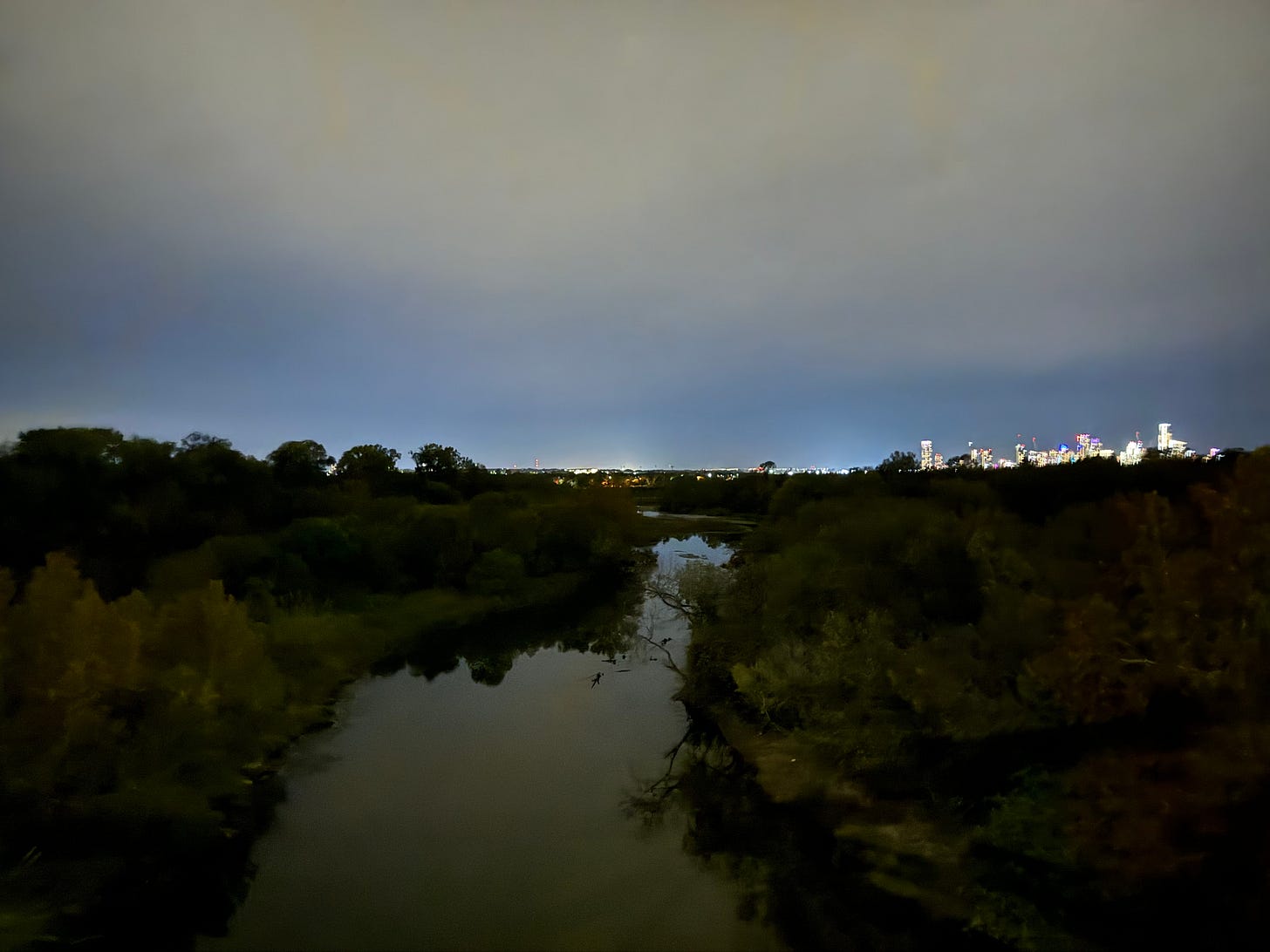
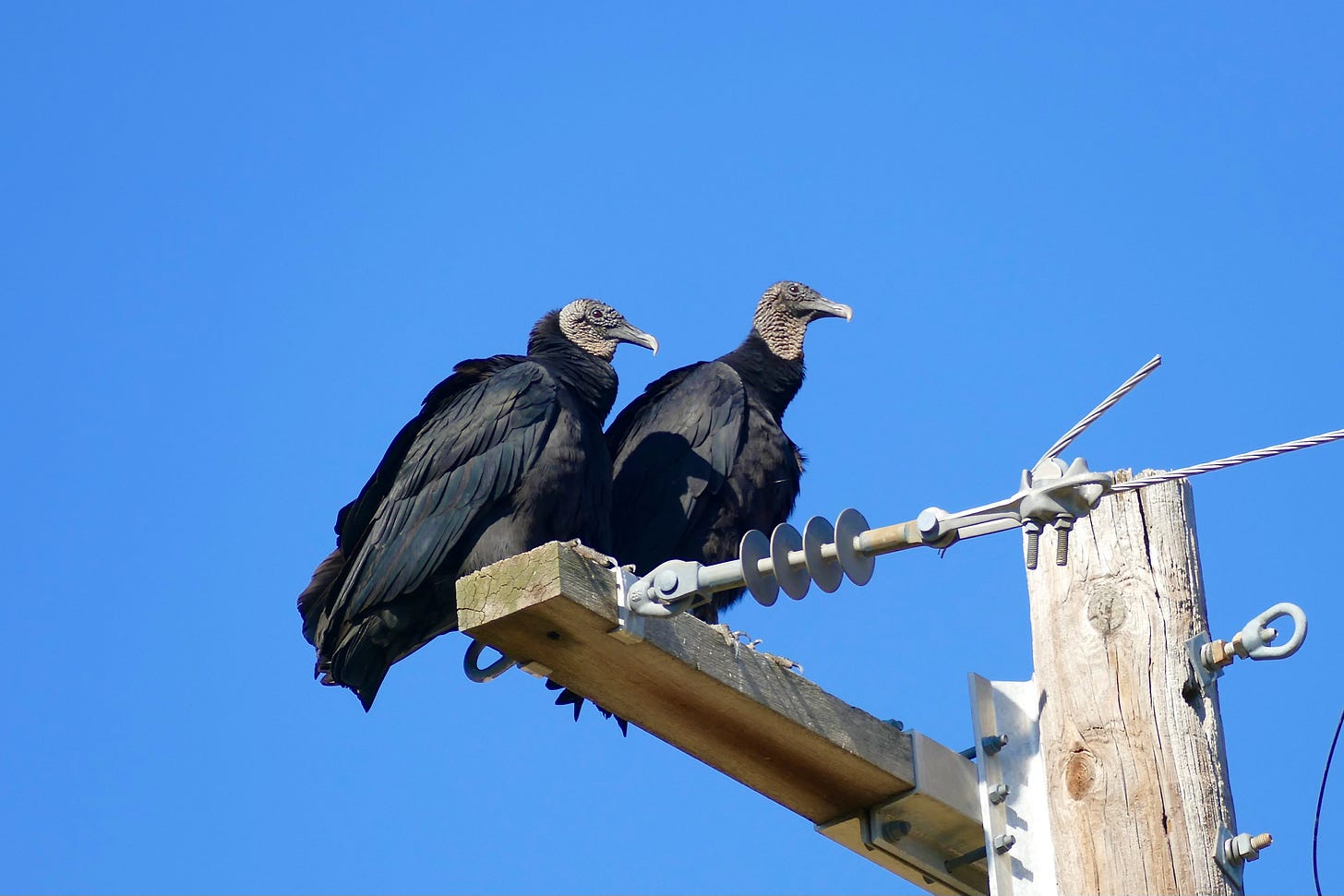
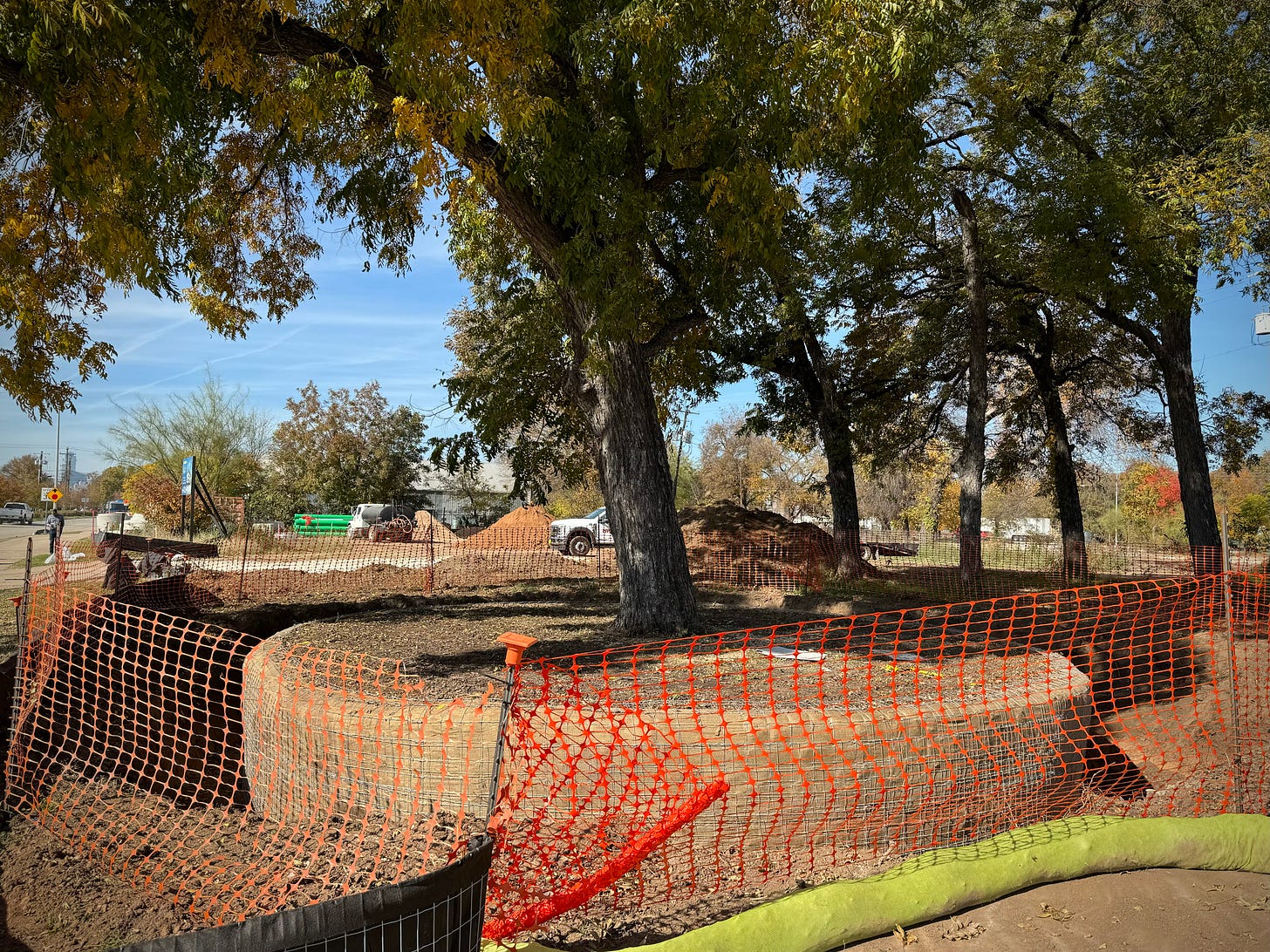

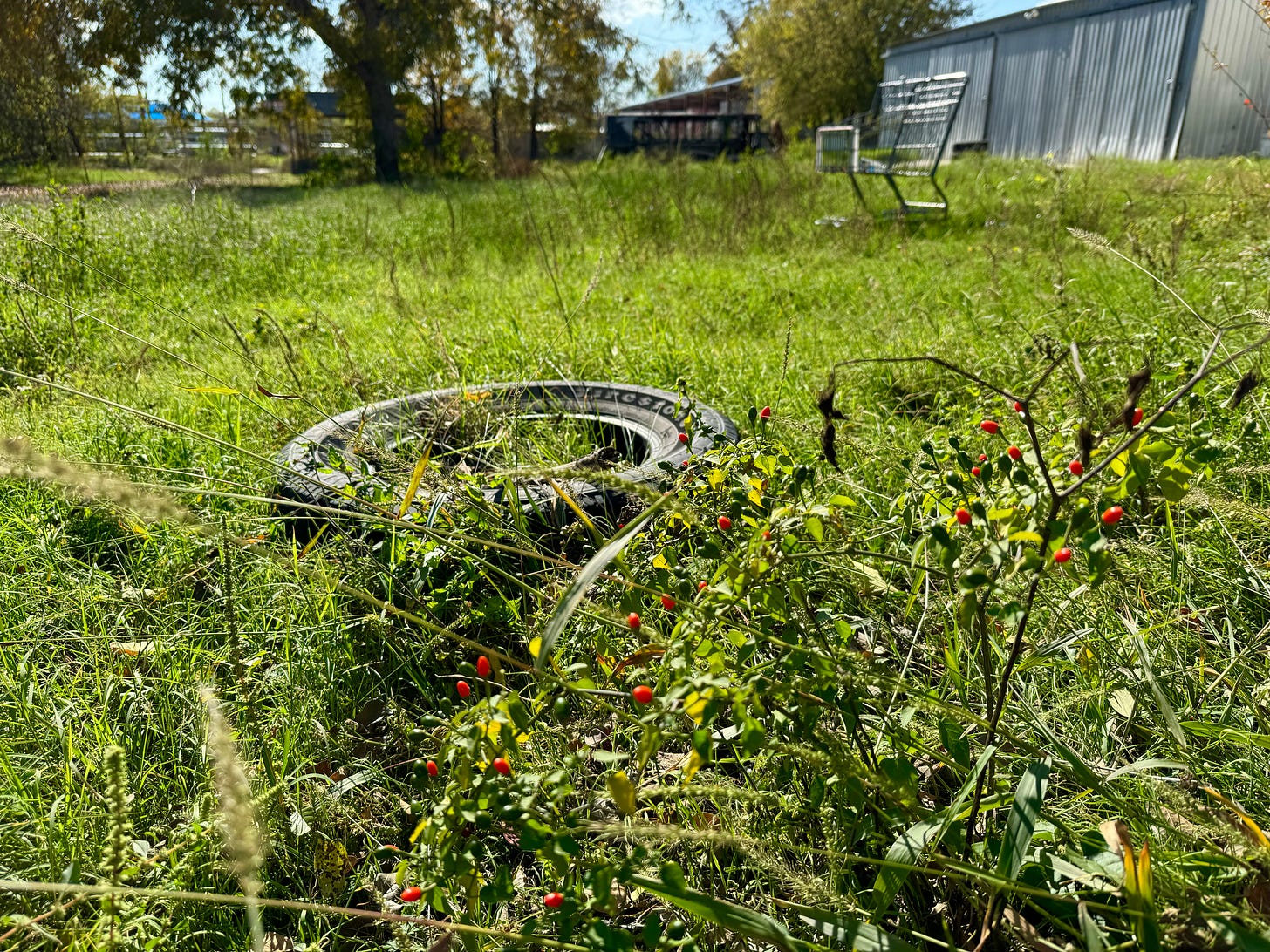
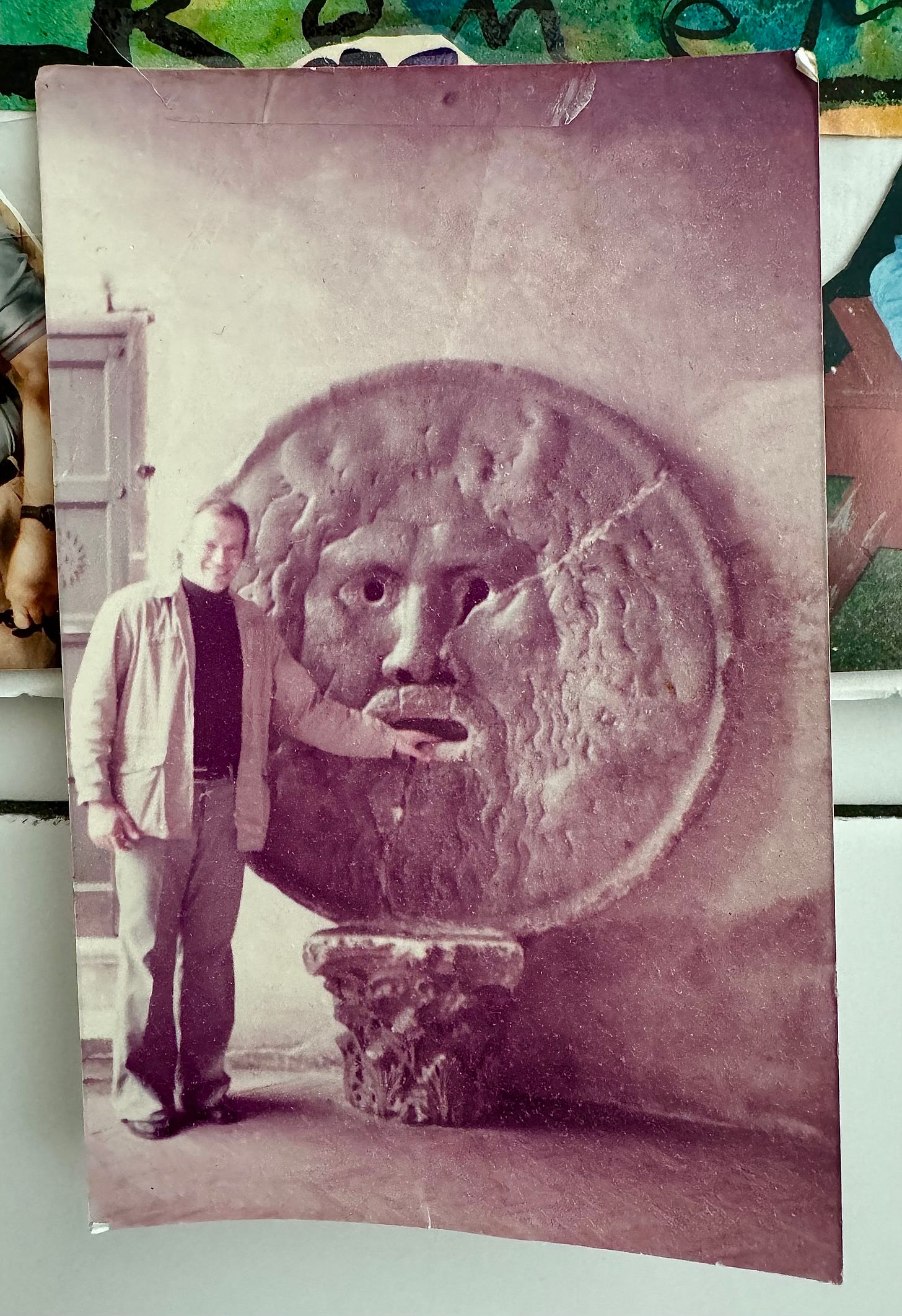
Did you happen to notice the nifty relo of several massive trees at the northeast corner of Dalton Lane and Old Bastrop Highway where the giant tilt walls are being erected? They are still on the property but moved to areas that are planned greenspace I presume.
Great essay, as always. There are pecan trees in a new story that I've been wrestling with this week, as it happens. And thanks for the kind words!